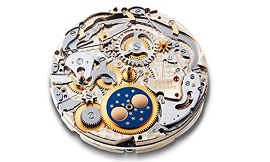Moon-phase display: Unterschied zwischen den Versionen
Zur Navigation springen
Zur Suche springen
| Zeile 4: | Zeile 4: | ||
A disc that rotates under the dial and is visible through an aperture. It shows the moon phases from full to new, generally as seen from the Northern Hemisphere. | A disc that rotates under the dial and is visible through an aperture. It shows the moon phases from full to new, generally as seen from the Northern Hemisphere. | ||
| − | Such mechanisms basically are known, particularly so in complex watches, and are used for instance as a secondary display in wristwatches. However, the lunar phases seen by an observer have an appearance that differs depending on his position onthe globe, in particular on the latitude, in a way already explained in the European patent application EP 1 445 672 originating from the International Watch Corporation (IWC). | + | Such mechanisms basically are known, particularly so in complex watches, and are used for instance as a secondary display in wristwatches. However, the lunar phases seen by an observer have an appearance that differs depending on his position onthe globe, in particular on the latitude, in a way already explained in the European patent application EP 1 445 672 originating from the International Watch Corporation ([[IWC]]). |
[[Category:Glossary]] | [[Category:Glossary]] | ||
Version vom 21. Februar 2010, 01:50 Uhr
Moon-phase display
| andere Sprachen: de nl ru |
A disc that rotates under the dial and is visible through an aperture. It shows the moon phases from full to new, generally as seen from the Northern Hemisphere.
Such mechanisms basically are known, particularly so in complex watches, and are used for instance as a secondary display in wristwatches. However, the lunar phases seen by an observer have an appearance that differs depending on his position onthe globe, in particular on the latitude, in a way already explained in the European patent application EP 1 445 672 originating from the International Watch Corporation (IWC).
